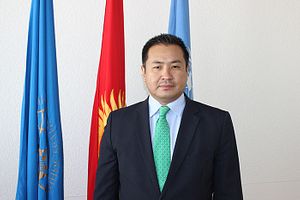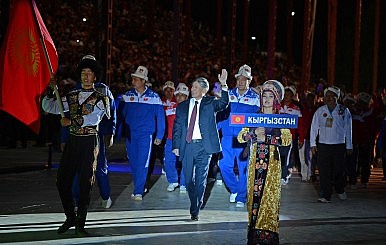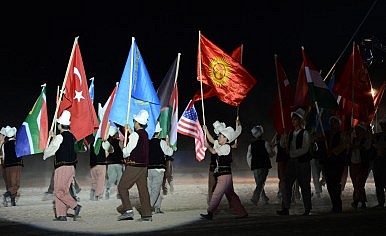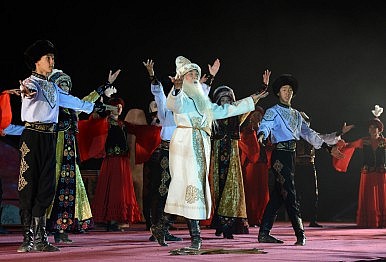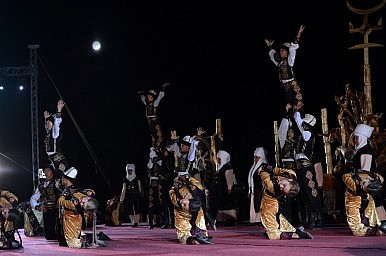The Kyrgyz Republic (or Kyrgyzstan) is a Central Asian country, bordering China, Kazakhstan, Tajikistan and Uzbekistan. Together with incredible natural beauty it boasts proud nomadic traditions. Kyrgyzstan gained its independence in August 1991, just after the collapse of the Soviet Union. The road since then has been rocky, with the country experiencing revolutions in 2005 and 2010. Today Kyrgyzstan is an island of democracy in Central Asia with a strong civil society and parliamentary-presidential political system.
Now Kyrgyzstan is trying to develop its own branded international events, such as the World Nomad Games, hoping to attract tourists and to build dialogue and diplomacy with other countries. The second World Nomad Games is scheduled to be held in September 2016. It comes at a time when the United Nations World Travel Organization considers Kyrgyzstan one of the world’s top 10 tourist destinations most likely to boom over the coming decade. Daniiar Mukashev, Permanent Representative of the Kyrgyz Republic to the UN and other international organizations in Geneva, recently spoke with The Diplomat’s Cholpon Orozobekova about the event and the tourism opportunities in his country.
Source: Sultan Dosaliev
This September Kyrgyzstan is hosting the second World Nomad Games. Why did Kyrgyzstan choose to pursue this initiative?
Kyrgyzstan President Almazbek Atambaev proposed in 2012 an idea of holding the First World Nomad Games (WNG). This initiative was welcomed by the Cooperation Council of the Turkic-Speaking States. The First World Games of Nomads were launched on September 9, 2014 on the shore of Issyk-Kul Lake, the Pearl of the Central Asia (the biggest lake in the country, ranking among the 25 largest lakes and the six deepest lakes in the world).
The mission of the World Nomads Games is the preservation and renaissance of the culture, identity and lifestyles of peoples all around the world in this era of globalization, the revival of the general historical cultural heritage of the nomadic civilization, strengthening friendship between peoples, and countering potential risks of to their identity. The main idea of the WNG is the implementation of ethnosport, ethnocultural and scientific programs.
The processes of the globalized world have aggravated the problem of preserving cultural identity. On the one hand, globalization is an objective process of forming and further developing integrated financial and economic space on the basis of informational technologies, a process of concentrating productive power; but on the other hand, it is the propagation of national and cultural identities, the homogenization, standardization and alignment of the world.
The Games will give a powerful boost to rehabilitating original national sport disciplines and revive the spiritual consciousness and historical memory of nomadic peoples around the world. The event is dedicated to showing the history of nomadic nations, their traditions, lifestyles and culture.
Today, unification processes are causing a gradual narrowing of cultural diversity. The challenges of globalization require solutions. In September 2008, UNESCO/TAFISA made the Busan Appeal on the Promotion and Preservation of Traditional Sports and Games that confirmed the importance of traditional games and sports as a vehicle for tolerance, integration, cultural awareness, solidarity, diversity and world peace.
The essence of the theory of ethnosport is promoting ethnocultural diversity through the development of traditional types of physical activity. It is the institutional form of a single social and cultural space for traditional forms of physical activity, sports federations and national sports resurgent throughout as a historical re-enactment of traditional games.
Nomadic civilization harmoniously coexisted with nature. Adapting to the ecological niche of their living space, nomads did not change the surrounding landscape. Contrary to widely held stereotypes, the culture and traditions of nomads were not only militaristic. Nomads spent their free time, holidays and celebrations playing various physical and intellectual games that have come down to us.
Source: Sultan Dosaliev
What kind of nomad games can we see in this festival? Could you please explain their origin? How have the games are adapted to the current realities?
In the first World Nomad Games, competitions were held in 10 sports: Kok Bory, Er Enish, Kunan Chabysh, Zhorgo Salysh, At Chabysh, Kyrgyz Kurosh, Ordo, Kyrgyz wrestling (Alysh), Kazakh wrestling (Kurosh), and Toguz Korgool. All are nomadic sport games that we have been preserving from centuries. As a part of the Games the national sports of Azerbaijan (Zorhana), Turkey (Jereed and different types of wrestling) and South Korea (Taekkyeon) were also held.
Along with sports activities the program also contained an ethnographic festival in the picturesque ravine Kyrchyn. The customs and traditions from the birth of a child, through his first steps, to a spectacular equestrian sports show were demonstrated in a large yurt city.
The Games brought together athletes from 19 countries: Azerbaijan, Austria, Afghanistan, Belarus, Brazil, Germany, Kazakhstan, Kyrgyzstan, Lithuania, Mongolia, Russia, the United States, Tajikistan, Turkmenistan, Turkey, Uzbekistan, France, Sweden and South Korea. Thirty sets of medals in 10 sports were on offer (a total of 166 medals). And the Games were covered by more than 250 journalists and cameramen from leading media outlets.
The rich cultural heritage demonstrated through the Nomad Games aroused great interest and drew positive feedback from viewers from more than 30 countries.
To further promote nomadic culture, the government of Kyrgyzstan decided to host the Second World Nomad Games (II WNG) in 2016. The Games are scheduled to be held from September 3-8, 2016, again on the shores of Issyk-Kul.
This time it is planned to increase the number of sports competitions to 25: a festival of combat sports, horseracing and horse competitions, archery contests, and demonstrations of different types of hunting with hunting birds and taigans (the Kyrgyz greyhound).
It is planned to build again a city of nomadic culture high in the mountains in the Kyrchyn gorge where the yurts of nomadic peoples with their interiors will be reconstructed together with craftsmen’s workshops for the production of handicrafts. A folk festival will accompany the participants and guests throughout the Games.
We, the Kyrgyz people, as one of the descendants of the nomadic civilization, are proud of the fact that the World Games of Nomads will be held in the country of the Celestial Mountains.
It is expected that this time the competition will be attended by 2000 athletes from 40 countries. The competitions will take place at the hippodrome of the city of Cholpon-Ata. The Kok Boru contest (a national horseback contest), horseback wrestling Er Enish, and Turkish Jereed (equestrian javelin contest) will be a part of the program.
Source: Sultan Dosaliev
Could you please tell us a bit more about some nomadic games? It would be interesting for our readers.
Of course, foreign spectators would be interested in watching the national game Ordo (a national game with sheep hucklebones and ankle bone shooting) and horseracing, Chong At Chabysh (long distance horse races of 60 km), At Chabysh (a 22 km race), Kunan Chabysh (horseracing feature two-year-old stallions), and Jorgo Salysh (a pacing race covering 11 km). Folk games and traditional merrymaking of nomadic peoples will be showcased. Audiences will be offered the chance to share the wonderful world of ethnic culture and take part in these games.
A combat contest will be held in the health and fitness complex at the Cholpon-Ata hippodrome. Athletes will pit their strength against each other in different ethnosports events, including the wrestling styles of Alysh, or belt wrestling (Kyrgyz Republic); Kazakh kuresh (Kazakhstan); Goresh (Turkmenistan); Gyulesh (Azerbaijan); Aba Kurosh (Turkey); and mass-wrestling (Tayak Tartysh), a national contest (Russian Federation).
Athletes from Hungary, China, Republic of Korea, Turkey, the United States, Japan, Mongolia and Kyrgyzstan will exhibit their exquisite proficiency in foot-borne and horseback archery at long range and for accuracy. The intellectual part of the contest will include the traditional nomadic games Toguz Korgool (Kyrgyzstan), Oware (Cameroon, Ghana, Antigua and Barbuda), Bao (Tanzania) and Mankala (Turkey).
The national hunting festival known as Salbuurun will also be organized. Various types of entertainment such as Taigan Jaryshy, or greyhound racing, Burkut Saluu, or raptorial bird hunting, Burkut Saluu, Chyrga and Yndok, all eagle hunting contests, and the Dalba Oinotuu falcon hunting contest will be presented to the audience.
Source: Sultan Dosaliev
According to the United Nations World Travel Organization, Kyrgyzstan ranks the world’s top 10 tourist destinations most likely to boom over the coming decade. Why do you think Kyrgyzstan is on this list? And what would you like to say to those still hesitant about traveling to Kyrgyzstan as a tourist?
Kyrgyzstan is an amazingly beautiful country, enclosed by very popular mountain ranges, glaciers and lakes of the world. Joyously unspoilt mountains capes, stark craggy ridges, and rolling summer pastures are brought to life by semi-nomadic, yurt-dwelling shepherd cultures. Add to this a well-developed network of home stays and visa-free travel, and it’s easy to see why Kyrgyzstan is the gateway of choice for many travelers in Central Asia.
The dynamic development of touristic sector in Kyrgyzstan led to increasing popularity in regional and international ratings.
It is time to explore Kyrgyzstan – a country of natural beauty. The government has created all of the necessary conditions to facilitate the arrival of tourists. In 2012, the government of Kyrgyzstan introduced a visa-free regime (60 days with no registration) with 45 countries whose GDP per capita is more than $7000. Citizens of 68 countries may enter Kyrgyzstan using simplified procedures (a visa can be issued by arrival at Manas International Airport). Taking this opportunity, I would like to point out that since May 7, Google has made it known that its Street View project now is available for Kyrgyzstan and comprises the biggest cities of Kyrgyzstan: Bishkek, Osh, Talas, Dzhalal-Abad, Uzgen, Tokmok, Cholpon-Ata, Kara-Kol and Balykchy. Moreover, with the support of the Department of Tourism, Google has chosen attractions of interest to international tourists. In general, at this time, about 20 places have already been included.
Cholpon Orozobekova is a Geneva-based journalist and analyst specializing in Central Asia.













